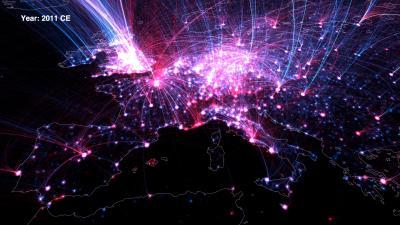Coral Gables, Fla. (July 31, 2014) -- Quantifying and transforming the history of culture into visual representation isn't easy. There are thousands of individual stories, across thousands of years, to consider, and some historical conditions are nearly impossible to measure.
Addressing this challenge, Dr. Maximilian Schich, associate professor of arts and technology at The University of Texas at Dallas, brought together a team of network and complexity scientists, including University of Miami physicist Chaoming Song, to create and quantify a big picture of European and North American cultural history.
Schich and his fellow researchers reconstructed the migration and mobility patterns of more than 150,000 notable individuals over a time span of two thousand years. By connecting the birth and death locations of each individual, and drawing and animating lines between the two locations, Schich and his team have made progress in our understanding of large-scale cultural dynamics.
The research is detailed in the article "Historical Patterns in Cultural History," published Aug. 1 in the journal Science.
Song, an assistant professor in the Department of Physics at the University of Miami College of Arts and Sciences, is a co-author of the study. A statistical physicist, Song's research lies in the intersection of statistical physics, network science, biological science and computational social science, broadly exploring patterns behind petabytes of data. Song's role of this project was primarily data analysis and model development.
"My research approach is mainly based on statistical physics, a sub-branch of physics that helps to understand the connections between macroscopic phenomena and microscopic details," Song said.

The visualization of birth-death network dynamics offers a meta-narrative of cultural history: Europe 0-1856 CE. [Press special -- Cf. Movie S1 in Schich et al.]
(Photo Credit: Copyright: Maximilian Schich & Mauro Martino, 2014)
"The study draws a surprisingly comprehensive picture of European and North American cultural interaction that can't be otherwise achieved without consulting vast amounts of literature or combing discrete datasets," Schich said. "This study functions like a macro-scope, where quantitative and qualitative inquiries complement each other."
Schich and his colleagues collected the birth and death data from three databases to track migration networks within and out of Europe and North America, revealing a pattern of geographical birth sources and death attractors.
"The resulting network of locations provides a macroscopic perspective of cultural history, which helps us retrace cultural narratives of Europe and North America using large-scale visualization and quantitative dynamical tools, and to derive historical trends of cultural centers beyond the scope of specific events, or narrow time intervals," says Song.
Other findings show that despite the dependence of the arts on money, cultural centers and economic centers do not always coincide, and that the population size of a location does not necessarily point to its cultural attractiveness. In addition, the median physical distance between birth and death locations changed very little, on average, between the 14th and 21st centuries, from about 214 kilometers (133 miles) to about 382 km (237 miles), respectively.
The topic of art and cultural history is an uncommon topic for papers in journals such as Science.
"A large amount of multidisciplinary expertise was necessary to arrive at the results we found." Schich said. "The paper relies on the fields of art history, complex networks, complexity science, computational sociology, human mobility, information design, physics and some inspiration from systems biology."
"There is an increasing realization that systems across different disciplines often share similar structural and dynamic properties," said Song. "Such similarities offer new perspectives and unique opportunities for physicists to apply their methodologies on a much broader set of phenomena."
Source: University of Miami